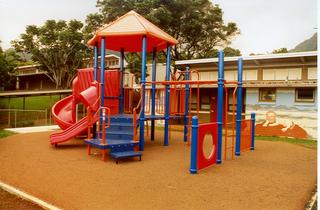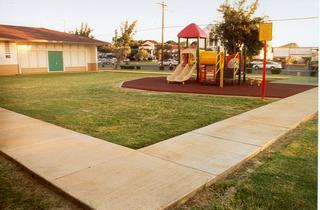Look at some of the older playgrounds and witness how the layout - not the equipment influences how many children you will find there. Two examples are the Waialae and Old Stadium playgrounds. The playground equipment is a center of attention - but only because kids have several diversions to occupy their time with including stairs, paths, shaded area, etc. These aren't engineering or architectural marvels - but they work.
 We are now seeing the new Hawaii DOE playgrounds in all of their cookie cutter glory. The equipment is well made but there is very little consideration to the age group that uses it or the preservation of safety that everyone seems to hold so dear. For instance there are two ground panels for toddlers or disabled children (loads of fun) and an overhead climber which if anyone ever did their homework on safety - they would soon discover that this feature is the leading cause of playground injuries. Its disturbing that after condemning all of the playgrounds that were in place prior to 1998, safety and recreation are not as great a concern compared to liability. There is a myth out there that if you have commercial play equipment that follows all of the CPSC guidelines - you are free from lawsuits. This has never been the case and a parent will sue if their child is injured. Claims are not able to be tallied since most settlements never even get to court. So it is a blind battle based on a premise of safety instituted by the playground industry that thrives off of such misperceptions. So what else can be done - this is where the discussion needs to begin.
We are now seeing the new Hawaii DOE playgrounds in all of their cookie cutter glory. The equipment is well made but there is very little consideration to the age group that uses it or the preservation of safety that everyone seems to hold so dear. For instance there are two ground panels for toddlers or disabled children (loads of fun) and an overhead climber which if anyone ever did their homework on safety - they would soon discover that this feature is the leading cause of playground injuries. Its disturbing that after condemning all of the playgrounds that were in place prior to 1998, safety and recreation are not as great a concern compared to liability. There is a myth out there that if you have commercial play equipment that follows all of the CPSC guidelines - you are free from lawsuits. This has never been the case and a parent will sue if their child is injured. Claims are not able to be tallied since most settlements never even get to court. So it is a blind battle based on a premise of safety instituted by the playground industry that thrives off of such misperceptions. So what else can be done - this is where the discussion needs to begin.Meanwhile, children are being raised by schools and not communities or their working parents. Their access to free-time and the outdoors is severely limited. I see children who step onto playgrounds for the first time at the age of five (just as the equipment sticker recommends) who are extremely vulnerable to injury because they have never taken a risk. Our society is changing and very little is done to give children an experience that at least replicates what they are denied - mainly the freedom to discover on their own.
Another issue regarding playgrounds has been ADA. Several contracts went out to Hawaii companies to build sidewalk accessibility for playgrounds. Recently I was passing the Kaimuki middle school playground on Waialae and saw how ludicrous this idea is. There is a sidewalk access on almost every inch of property creating trip hazards everywhere. Any thoughtful approach at creating a sidewalk for wheelchairs would not include a 6 to 8 inch drop at the edge. The Hawaii DOE has entirely ruined the play area and have done it a way that does not even comprehend what ADA requires. I suppose their motivation is compliance, but they really messed it up for the kids.
I could go on and on but it may be better to cut it here and simply ask you to write a story on this some day soon. All I really see coming out of the Newspapers is an assumption that building a playground (what ever it may be) is a good thing. Even though I support outdoor recreation, this use of public tax dollars would be better spent on teachers - at least until a better approach can be addressed.

No comments:
Post a Comment